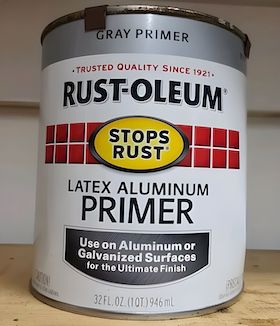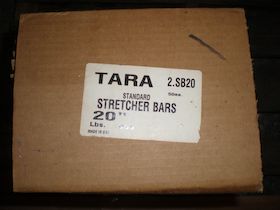
-----
Aluminum as 'art' painting surface
ACRONYMS:
ACM = Aluminum Composite Material. Building panels constructed in sandwich fashion, with thin aluminum sheets on each side and a core of polyethylene or other light plastic
ACP = Aluminum Composite Panels, same as ACM
Q. Just purchased some ACM panels for my oil painting projects. The panels are intact but some of the corners are bent or smashed, and one of the panels has a big dent in the center. How does one repair this kind of damage? Suggestions/comments would be most appreciated.
Mary Tong- Honolulu, Hawaii
November 8, 2021
⇩ Related postings, oldest first ⇩
Q. Hello everyone,
I am a artist and have some questions about using aluminum, or any metal, as a painting surface. I work in oil paints and have been using various types of hardwood plywood and MDF board. I am not happy with their longevity and how they warp over time. I have been preparing my surfaces by building up acrylic primer, gesso [affil link], usually five or six coats, sanding between each coat. I am interested in Aluminum because it is so smooth and seems as though it will last forever. So here are my questions: What is the best Aluminum to use as a painting surface and where do I obtain it? (I saw some aluminum sheeting that was nearly an inch thick and looked corrugated in a gallery, what is this?) How do I prepare the raw aluminum to hold paint forever, do I need to do anything beside sanding it?
Thank you for your responses and I am sorry I do not know the technical aluminum jargon.
Best,
Colin Whitehttp://cwht.net - NYC, New York
2002
A. Hello Coln!
Aluminum should work very well for you as a painting surface! It is readily available in flat sheets up to 4 by 8 feet, sometimes even greater, and is available with textured finishes (where the mill rolls in an embossed pattern) as well as the standard flat, smooth material you envision. I took a quick look at an industrial hardware supplier's catalog, and they listed a 4 by 8 sheet, 1/8 inch thick for $218. You can likely do better by calling an aluminum supplier found in the yellow pages.
Since you merely want the aluminum to support paint, you don't need the high strength grades. I'd recommend a 1100 or 6061 grade because they are common, least expensive, and readily take the preparation steps. The easiest of these prep steps is a chromate conversion coating, often referred to by the trade names of 'Alodine' or 'Iridite'. This will put a very thin (millionths of an inch) 'coating' on the aluminum- actually it is converting some of the surface aluminum to a chromated oxide. The better, more complex preparation step would be anodizing, wherein you make your aluminum an anode, put it in an acid bath, and run electricity through it to greatly thicken the natural aluminum oxide layer. It's still a pretty thin layer- sulfuric acid anodizing is only a few ten-thousandths of an inch thick- but it's thick enough to make a superb paint base. Prime it, and you're ready to make a work that will last as long as the paint.
I'd suggest having the preparation steps, either the conversion coating or the anodizing, done at a commercial shop: you can find some here at finishing.com, or if none of those fit your needs check the yellow pages or web search engines.
Good luck!

Lee Gearhart
metallurgist - E. Aurora, New York
2002
A. To Lee and Colin, (in response to Colin's inquiry about aluminum preparation for art painting surface.)
I am an artist/painter who has been using bare aluminum panel for awhile but only recently discovered the metal primer I have used is insufficient to protect the metal from long term corrosion. Lee mentions both anodized and chromate conversion, both of which I am investigating. I have found a possible problem that Lee may not have considered. The primer paint coat he mentions will have a problem adhering to the anodized surface unless it is "roughed-up" with asandpaper. This is the normal procedure for applying primers to a smooth bare surface. A fine grit paper may have the potential to breakthrough the very thin layer of anodization and/or the chromate conversion he is suggesting. I wonder if Lee could comment on this. This is a painter problem essentially but it is leading me to consider POWDER COATING as a better way to go for Colin's situation. For more info on this and comparison to anodized properties.
Best,
Mark Dorrancehttp://www.markdorrance.com/recent/rw124.html - NYC, New York
2002
2007
Q. Hi,
My current approach, or the beginnings of an approach, as an artist wishing to paint on scrap aluminum (sheet metal left over from a custom car fabrication shop), has been to prepare the metal by glass-beading, and then to use a "zinc chromate" primer, which I think I've found as a multi-metal primer at an Ace hardware store...
Is this sufficient for fine art applications?
And...then what? Can I paint with conventional artist's acrylics, or oils, or must I use something like automotive-grade paints?
I'm interested largely in applying washes or glazes, plus developing dimension or texture beneath them; I'm also interested in achieving a deep transparent gloss coat atop the work, at least in parts of my paintings.
I'd also welcome any ideas on how to attach stuff to the back of the aluminum sheets, to make them simple to hang on a wall, once I've finished them.
(I'd also welcome any and all contact from other artists working with sheet metal, for the purposes of information exchange.)
Thanks so very much!
https://www.flickr.com/photos/heronmoondesignworks/ - Lucerne, California
A. Hi, Terri. Although the Alodine 1201 ⇦ on eBay or Amazon [affil link] or "Iridite" chromate conversion coating mentioned by Lee is ideal, that really should be done at a metal finishing shop; your alternative of a zinc chromate primer or an automotive primer. Anodizing, powder coating these will work; powder coating will be cheaper.
Personally I think you all are thinking about it too hard, It's aluminum it will last long enough for your grandchildren's grandchildren to appreciate it if you treat as you would any other piece of fine art. I have yet to receive any complaints from any of my clients regarding corrosion over time or problems with paint adhesion. Thanks for listening, check out my site!
Brian Fredellahttps://www.flickr.com/photos/imwbusiness/ - Inner Metal Works - Bedford, Texas. USA
2007
Q. Hey all,
I've been using fine art oil paints on aluminum as well . . . don't know why we have to prime it at all . . . please explain. Will it eventually peel? Is that the issue?
https://www.facebook.com/claudine.luchsinger - Narrowsburg, New York
June 26, 2010
Q. I appreciate all the comments regarding painting on aluminum. I would like to paint on aluminum that will be displayed outside exposed to the elements. Would I need to use exterior acrylic or oil paints and is the prep the same?
JJ Atwellart teacher/artist - Frederick, Maryland, USA
June 29, 2010
A. Brian Fredella again, JJ Atwell the answer to your question I think is, yes...I don't think the aluminum surface has anything to do with it if the paint is not sealed with a uv resistant exterior grade topcoat (Permalac [adv: Permalac on eBay]) I don't think you could expect it to hold up over an extended period of time no matter what it is painted on. Claudine L, I side with you on this one, I don't think a primer is necessary, gesso, zinc chromate, anodize, Alodine, etching primer, powder coat, none of it. What you need is surface prep. I use 80 grit with an orbital sander or media blaster, and have never had a client complain of problems with adhesion. The paint will not peel if properly prepped and cared for as fine art should be. Aluminum must be clean and free from dirt and oil before painting. Hope this helps.
Brian Fredellahttps://www.flickr.com/photos/imwbusiness/ - Inner Metal Works - Bedford, Texas. USA
July 23, 2010
![]() Thanks all for a lot of valuable information. I checked out Brian Fedella's website/store. Brian: For a second, the word 'Canvas' made me think it was Canvas-mounted Aluminum supports. Since art-support is a well understood term, and you do use the term 'Metal Art Support' too, may I suggest that the word 'Canvas' may be completely removed from the product descriptions/store items. Thanks.
Thanks all for a lot of valuable information. I checked out Brian Fedella's website/store. Brian: For a second, the word 'Canvas' made me think it was Canvas-mounted Aluminum supports. Since art-support is a well understood term, and you do use the term 'Metal Art Support' too, may I suggest that the word 'Canvas' may be completely removed from the product descriptions/store items. Thanks.
- Virginia, USA
October 30, 2010
A. Aluminium Composite Panel usually comes in 8 x 4 feet size, having normal thickness of 4 mm. However, 4mm is too thin and tends to bend easily, so go in for 6mm thickness. Have them cut with care, otherwise it tends to bend near the edges. To prepare properly, just scrub the surface with sandpaper (rough ones that come in about 4 inch thickness and measured in lengths of meters (just small pieces would do). After the surface is scrubbed properly by sandpaper, use industrial spirit (like the one used when spirit polishing wooden furniture), and properly clean the surface. Then, instead of using gesso etc, just use directly from tube itself of acrylic paint and apply with wide brush on surface. If using white, then once up down, then followed by once sideways after drying. The acrylic paint has strong binding of its own, and once it is dry, the surface is ready for fine painting. A painting done in this way is showing no problem even after 5 years now, in spite of there being a lot of humidity and heat where I live. If it were painted on canvas, there would have been patches here and there, mostly of fungus. But painting on aluminium composite panel has no such problems.
himalaya [last name deleted for privacy by Editor]- shimla India
January 13, 2011
Q. Dear all,
Thanks for all the work you've done already on oil paint and aluminium. I was wondering, are there different kinds/blends of aluminium too and what kind is the best fit for oil paint? Love to hear from you and exchange information.
Normally you would use an special gesso or metal primer under oil paint for the adhesion of the paint and that the oil will not get in to the underground. With aluminium I can imagine that it won't be necessary (only the sanding makes sense then).
- Zeist, Netherlands
April 26, 2011
! An example of fine art painting on aluminum is the work of artist Steven Alexander.
His geometric paintings on aluminum show a high level of achievement and outcome.
- Greenwich, Connecticut
July 23, 2011
June 5, 2011
I make "weatherproof" fine art using Golden brand acrylic paint. The aluminum sheet may be part of a sculpture or 2-dimensional work, and the paint needs to stick! Through rain and sun and wind! I've been painting on acrylic sheet; this is weatherproof, but brittle, and I'd like to switch to aluminum, which I love.
Dot LingrenQ. I am interested in painting 3/16 sheet aluminum after cutting into designs with a plasma cutter. (Do I need a particular aluminum alloy)
I want to layer a paint oils or aluminum dyes in varying layers and opacities to in fact create an artistic painting or even a sculpture with solid colors.
I am also thinking of texturizing/abrading/ scratching the surface of the aluminum.
Then finally automotive clear coat. How do you suggest I do this. And how much would it cost say for a 2 foot square sheet? The art would be hung indoors mostly.
Are aluminum dyes sold by pints, gallons etc what would be relative pricing? how toxic are they. Thanks so much Greg in Vancouver Canada
artist - Vancouver, Canada
January 26, 2012
Q. Hello - I am an artist in Canada who has been using aluminum as my substratum for 5 years. I have had wonderful results. Please check out www.darleanmorris.com for my art.
Usually, I approach a metal sign company to create my aluminum "pans". They are approx. 40 x 36" and 42" x 36". My intent is to go larger! I prepare them by gentle sanding and cleaning, then use the paint directly on the metal. Oil has a natural bond or marriage with the aluminum.
Aluminum is a wonderful surface to work on. I never have to worry about the 'canvas' breaking!
Let me know if you have questions.
Darlean
www.darleanmorris.com- artist who works on aluminum - St. Marys, Ontario, Canada
February 4, 2012
RFQ: Hey Everyone,
Does anyone have a source where I can buy ready made aluminum canvas'? I have been google searching and trying to avoid having to have them specially made by a metal fabricator, etc. I would like them in 20 x 20 or larger. I would also appreciate any information on any company that might make aluminum canvas'.
Thanks in advance.
- Charlotte, North Carolina USA
February 12, 2012
Ed. note: This RFQ is outdated, but technical replies are welcome, and readers are encouraged to post their own RFQs. But no public commercial suggestions please ( huh? why?).
A. I've been painting on galvanized sheet metal (26 ga.) for over 30 yrs. and have had no durability issues with the following process. First I etch the metal, flat and level outdoors, with a fairly strong dilution of muriatic (hydrochloric) acid. I let the surface cook for a few minutes and then rinse well with water. I then let it drain in a vertical position. It's a good idea to neutralize the acid with a baking soda [in bulk on eBay or Amazon [affil link] and water solution. Let that dry and wipe down with a clean lint free rag or paper towel damp with denatured alcohol. Remember to use proper protection because the fumes from the zinc and acid are toxic. A respirator is necessary as well as rubber gloves and eye protection. A rubber rain suit would be a good idea. Then prime with a suitable galvanized metal primer. I've used different water based products and they all seem to work well. Recently I've been using a greenish translucent primer from Sherwin Williams that is water based and easy to use. When dry enough to recoat, I've been priming again with 1 or more coats of any good primer. I think that white gesso might give the best ground. I roll it with a short nap lint free roller and lay it off with a 3" brush in one direction. I usually apply more than 1 coat and lay these subsequent coats off in the opposite direction. This (the brush strokes at 90 degrees to each other) gives me a "tread effect" mimicking the look of canvas. It could be sanded smooth of course. Be sure that the primer coats the edge of the metal so that it won't rust. All things considered, aluminum may be a better choice and the aluminum composite panels seem interesting. Does anyone know about the pre-painted aluminum sign blanks, etc. that come with a gloss finish? Can sanding and repriming provide a durable base which won't have any adhesion issues? I believe they are also available with a matte finish.
Chris Recker- Houston, Texas, USA
June 19, 2012
Q. My daughter has been painting on aluminum and making beautiful jewelry out of the paintings. We have used something called Ice Resin
[affil link] to finish the pieces. This has become a challenging process in that the resin is inconsistent and messy. I can't see this as a viable option for long term production. Does anyone have any suggestions for finishing pieces that would create a similar look to resin but not be so difficult?
Also, I am looking for resources for colored anodized aluminum in larger pieces.
Thanks for your help.
Tamara
- Minnesota
August 24, 2012
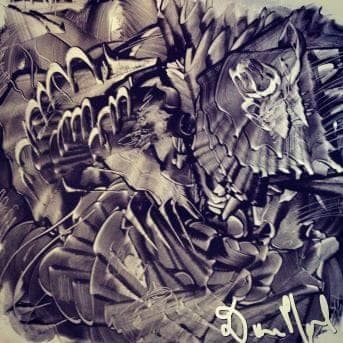
Q. Hello,
I love painting directly onto aluminum with acrylic paint! I purchased a sheet at Home Depot sanded and cleaned with a 50% solution of vinegar
⇦in bulk on
eBay
or
Amazon [affil link] and water. My question is how to preserve the painting? If I try to varnish I feel it will smear, even though it has dried. Do I have to apply a varnish?
Thank you
Frustrated in NJ
- Galloway, New Jersey USA
September 16, 2012
Q. How do you hang the sheet metal paintings? I want to try my luck using aluminum sheets but don't have a clue on how to hang the art.
Jay crabb- Paris Texas
July 8, 2014
A. Hi all
Re: hanging aluminium artworks, I use 'U' shaped aluminium bars that attach one near the top and one near the bottom of the piece. I attach it with two part epoxy glue epoxy_adhesive+.html
⇦ on
eBay
or
Amazon [affil link] and it stays just fine. I drill two holes at the top of the bar I want to hang from and string hanging wire. This way makes sure your work hangs an equal distance from the wall at the top and bottom and reduces swing or movement of the piece. I have had some of these works over ten years with no problems yet as far as hanging. I like to use for photo mounting.
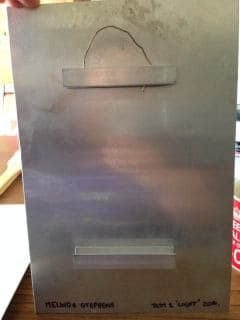
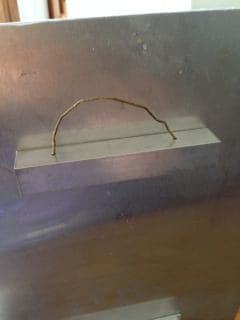
Hope this helps.
Melinda StephensArtist - Perth, WA, Australia
September 6, 2014
Nose Art Painting on Aircraft

Q. I am a flight jacket artist used to working with acrylic dyes. I have been commissioned to do "Nose Art" on a WWII P-51 Mustang and am looking for ideas on the best paint to use to do the job that will last for the lettering and pin-up art. Any ideas and suggestions are welcomed!
Kevin WisniewskiArtist - Milwaukee, Wisconsin, USA
September 17, 2014
Q. I see that most of you are artists, I'm not, I do custom woodworking. My use for Aluminum is in this particular instance is using 3/16" x 2.5" x 7" bars to span a space on in a contemporary styled table. The bars span a 1" space that connects the two slabs.
The aluminum bars are spaced 1" apart and the groups of two are spaced 24" from each other. Long table my concern is putting a catylized lacquer over the aluminum when finishing. The bars will be epoxied into the 2.5" slabs. There is a 1" space between the two slabs as I was saying. In total there will be (8) 3/16 inch bars bridging the gap to hold the table halves together.
I thought I'd explain my use. So I most likely will be using a catalyzed lacquer as mentioned as my top coat. I would like to know if just prepping with an automotive aluminum prep or something of that nature will be enough? Remember this is a dining table and it might see some moisture once in a while but not excessively. I want to be able to finish the surfaces at the same time. Once I start to spray I would like to be able to coat everything.
I'm up for suggestions
thank you
- Lower Burrell Pennsylvania
November 24, 2014
Q. I am a fine arts painter and I use 125 Mill Finish Aluminum bent into a shape as my painting substrate. I scratch the front with steel wool, clean it and then apply DTM Bonder made by Sherwin Williams. This bonder accepts water based acrylic paint. I then proceed by laying down a layer of acrylic gesso, then I begin my creative process.
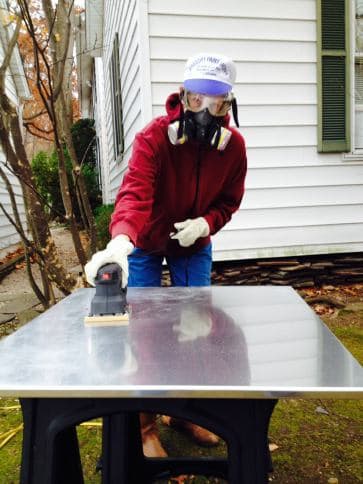
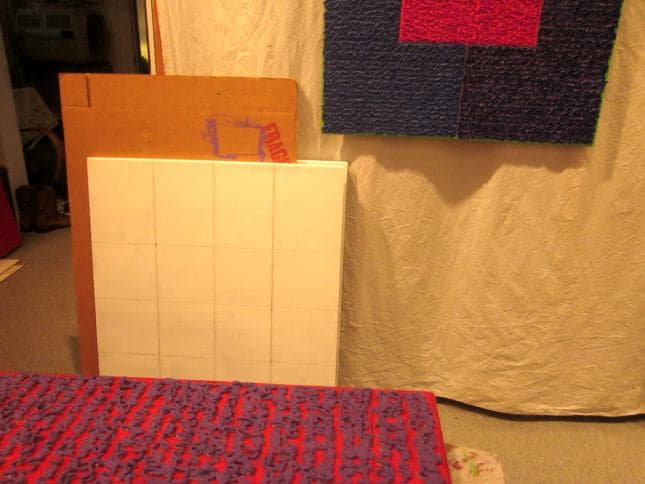
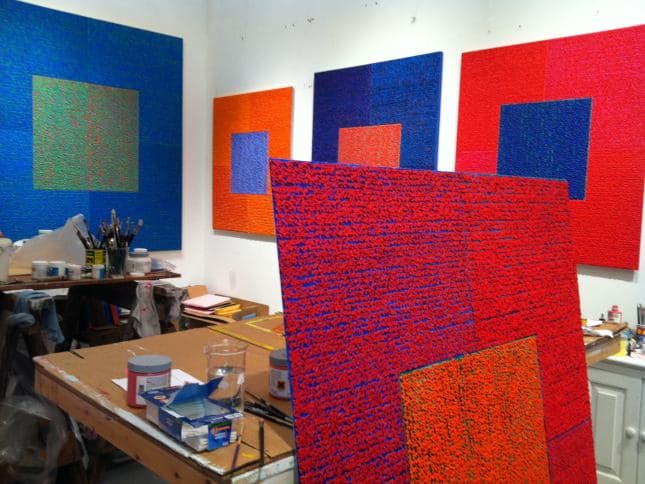
In years past, I had been treating and painting the back of the paintings as well. I gave up this practice because it both added to my prep time, and created another surface that had to be watched for scratches, etc. Part of the appeal of the works is that they are made upon thin pieces of bent aluminum, and having the bare metal exposed added to the appeal of collectors, etc. It has recently come to my attention via another artist that the aluminum will oxidize and corrode - white power/flakes will eventually populate the back of the paintings. I asked my fabricator and he didn't know anything about this. I also asked an architect and he felt that because these works are indoors and handling as art objects, that they would never be subjected to the "elements" which cause corrosion. My colleague tells me that just human fingerprints will cause this oxidation and break down of the aluminum.
Can you tell me if I need to be coating the backs of these works? Of course after nearly a decade of production this becomes a HUGE job - as many of the paintings are already in private, corporate and museum collections. I don't care if the aluminum becomes discolored on the back of the work - but am concerned if it will begin to flake. What are your recommendations?
L P Sloanelouisepsloane.com - NY New York
February 4, 2015
A. You can buy canvas covered aluminum plates at naturalpigments.com.
Massimo Mazzon- Menlo park, California
February 22, 2015
Q. Have been reading all above posts, as my interest is in painting aluminum for bracelets. Wondering what best choice coating would be after painting? Would appreciate any suggestions.
S Sawyer- Payson, Arizona, USA
April 26, 2015
Q. Can you tell me where I can get the sheets of aluminum to paint on?
Jerry hicks- montague, Michigan, USA
April 1, 2016
Q. Hi everyone,
I am an oil painter who works on canvas. I use refined linseed oil and thinner while painting. My question is about longevity of the painting. Since aluminum does not have pores, it can not breathe. Will over time the paint peel? I understand about sanding and priming properly but underneath it is still a solid surface of aluminum. How many years will oil painting on aluminum last? What about different weather conditions?
Thank you in advanced for any input, Lisa
lisabottolee.com - Weston, Florida
November 1, 2017
A. You might look into the history of copper coated panel painting for oil based paintings. There is a long tradition of it but the surface must be prepared properly. I haven't done it myself but should be easy enough to look up.
Raphael LyonArtist - brooklyn New York Usa
November 19, 2017
Q. I paint on aluminum trays using acrylic paintings, those trays are ready to be used or hang on the wall so my question is what is the best cover material should I use in order to make my art work last forever and protect it from scratches and hot water is it spray paint or acrylic varnish or something else?
Maha ZedanI'm a handmade artist and I display my products at several galleries - Alexandria,Egypt
December 8, 2017
A. Regarding varnishes on acrylic and what lasts "forever", it's problematic. From a museum conservator's standpoint, a varnish is something that is removed periodically as it ages over decades or centuries, and then a new varnish is applied. Acrylic paints don't take such abuse terribly well because they remain soft and pliable. They are also soluble in a lot of substances. Even the mechanical action involved in removing and applying a varnish, can change the structure of the painting. http://www.justpaint.org/conservation-of-acrylic-paintings/
For these reasons many artists don't varnish acrylic paintings at all. This leaves the acrylic exposed to other hazards, notably dust and grime in the environment. The soft surface picks those up easily. But when alternatives are worse, people accept what they must. Acrylics still have many long term durability characteristics, for instance they are much less prone to cracking than ancient oil paintings. If you're trying to decide "what medium will last forever" acrylics is still a really good choice overall.
Ed. note: This RFQ is outdated, but technical replies are welcome, and readers are encouraged to post their own RFQs. But no public commercial suggestions please ( huh? why?).
Van Every
- Asheville, North Carolina, USA
December 16, 2017
A. Hi. I make painted sculpture and have done several public pieces using aluminum. The process is simple. Make the piece then take it to a professional metal finisher. Have them put a protective undercoat particular to aluminum (usually a chromate). Then I paint with outdoor grade acrylic paint. As a final step I have the finisher apply a two part clear epoxy like that used on cars. For outdoors I have the finisher do three coats. I have pieces up in a north atlantic coastal port town for over 15 years and they are still doing very well. Better than I ever imagined.
Laurita PescadorHuck Fisher Metalworkers - Oaxaca, Oaxaca, Mexico
August 2, 2018
September 3, 2018
A. Andreas Nottebohm, a German artist, is widely regarded as one of the key innovators of Metal Painting.
Another contemporary practitioner worthy of note is Jeff Sturgeon, an award-winning science fiction illustrator from Portland, Oregon, whose greater fame in the Sci-Fi community stems from his fine art paintings on textured aluminum plate stock. If this subject interests you, then you simply MUST see his work; photographs and prints don't do it justice.
I don't believe either of these artists use chemical processes to prepare or preserve the metal, but they brush and grind to generate textures, which seem to be more for visual effect than for keeping the paint on, although I suppose it helps. Actually, I think much of their works are rendered with acrylic dyes which are absorbed into the metal.
John Granackihttps://www.facebook.com/Granacki/- Master of Space & Time - Grants Pass, Oregon, USA
Q. I have a piece of honeycomb aluminum panel I would like to paint on with oil paint. The panel has a factory applied baked polyester sealer coat on both sides. Might anyone have an idea how I might prep the surface to take a primer? Apparently the polyester surface is very non adhesive.
Thanks ... Will
artist - emeryville, California usa
February 16, 2019
Applying artist acrylic gesso to sanded Kynar aluminum panels
Q. Hi,
I am a fine artist, I paint in oil paint. I am switching from painting on boards to aluminum panels (omega bond/Diabond). These panels come coated in Kynar paint. My approach is to lightly sand the kynar to give it some roughness for the acrylic gesso paint to adhere too. My question is, will this have good adherence? Or is it better to get unfinished anodized aluminum and paint directly on that?
Thanks,
Alan
- Northampton Massachusetts
October 20, 2020
A. Hi Alan. There is another thread here where a painting contractor claims he could not get good adhesion onto Kynar window frames even after careful sanding; I'd be very wary of satisfactory adhesion of artwork onto Kynar. I believe similar panels are available with several different paints or primers, and I think any of them would be better than Kynar, or anodized, or raw aluminum. Good luck.
Luck & Regards,

Ted Mooney, P.E. RET
Striving to live Aloha
finishing.com - Pine Beach, New Jersey
Ted is available for instant help
or longer-term assistance.
October 2020
Q, A, or Comment on THIS thread -or- Start a NEW Thread
